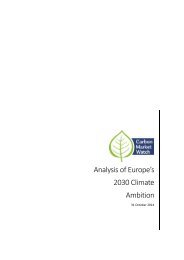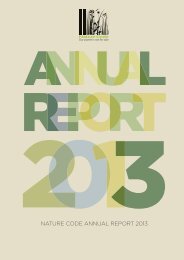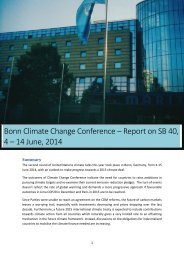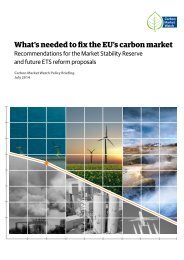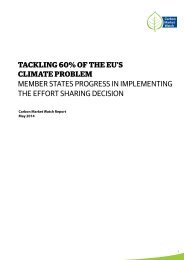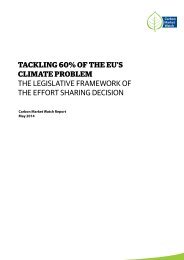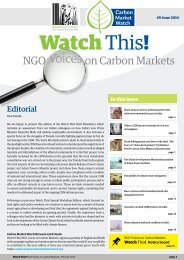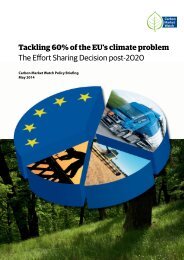What’s needed to fix the EU’s carbon market
Create successful ePaper yourself
Turn your PDF publications into a flip-book with our unique Google optimized e-Paper software.
RECOMMENDATIONS TO FIX THE EU ETS<br />
ADJUST THE EU ETS CAP TO THE 2050 OBJECTIVE<br />
Implementing <strong>EU’s</strong> 2030 target requires an increase of <strong>the</strong> linear<br />
reduction fac<strong>to</strong>r (LRF) by which <strong>the</strong> EU ETS cap is reduced each<br />
year. The linear reduction fac<strong>to</strong>r needs <strong>to</strong> be in line with <strong>the</strong> overall<br />
objective of keeping climate change below 2°C. The current linear<br />
reduction fac<strong>to</strong>r of 1.74% does not do this, as it brings <strong>the</strong> EU ETS<br />
<strong>to</strong> only 73% reductions by 2050 compared <strong>to</strong> 2005. As part of <strong>the</strong><br />
ETS revision <strong>to</strong> implement <strong>the</strong> <strong>EU’s</strong> 2030 emissions reduction target,<br />
<strong>the</strong> LRF needs <strong>to</strong> be changed <strong>to</strong> 2.6% <strong>to</strong> allow reductions in <strong>the</strong> ETS<br />
sec<strong>to</strong>r of 47% by 2030 and 96% by 2050 compared <strong>to</strong> 2005.<br />
PERMANENTLY REMOVE 1.6 BILLION SURPLUS ALLOWANCES<br />
Cancelling <strong>the</strong> inflow of international offsets by removing at least<br />
1.6 billion of <strong>the</strong> excess allowances protects <strong>the</strong> domestic nature of<br />
<strong>the</strong> 2030 GHG target. This also ensures that <strong>the</strong> <strong>carbon</strong> <strong>market</strong> does<br />
not cancel out abatement from o<strong>the</strong>r European policies that reduce<br />
emission by turning <strong>the</strong>se emissions reductions in<strong>to</strong> future rights <strong>to</strong><br />
pollute.<br />
IMPROVE THE MARKET STABILITY RESERVE<br />
The EU ETS needs <strong>to</strong> be revitalised so that it promotes investments in<br />
clean technologies, rewards companies that produce more efficiently<br />
and encourage fuel switching from polluting coal <strong>to</strong> cleaner gas<br />
and renewables. The Market Stability Reserve aims <strong>to</strong> address <strong>the</strong><br />
imbalance between <strong>the</strong> supply of and demand for <strong>carbon</strong> permits<br />
and helps <strong>to</strong> mitigate <strong>the</strong> downward pressure on <strong>the</strong> <strong>carbon</strong> price<br />
as a result of renewable and efficiency targets, but it fall shorts of<br />
providing a structural solution for <strong>the</strong> surplus. Bringing forward <strong>the</strong><br />
operation date of <strong>the</strong> reserve and permanently removing excess<br />
allowances leads <strong>to</strong> a more stable <strong>carbon</strong> price development.<br />
NO FUTURE ROLE FOR INTERNATIONAL OFFSETS<br />
After 2020, <strong>the</strong> EU ETS needs <strong>to</strong> be designed so it promotes domestic<br />
action and European investments in clean technologies. Allowing<br />
companies <strong>the</strong> option of using international offsets <strong>to</strong> comply with<br />
<strong>the</strong>ir reduction obligations delays <strong>the</strong> necessary transformation<br />
<strong>to</strong> a European low-<strong>carbon</strong> economy and potentially even leads <strong>to</strong><br />
an increase in global emissions 27 . After 2020, international offsets<br />
should hence not be allowed for use under <strong>the</strong> EU ETS.<br />
FULL AUCTIONING TO REFLECT THE POLLUTER-PAYS-PRINCIPLE<br />
Until 2020 industrial sec<strong>to</strong>rs will receive <strong>the</strong>ir allowances for free,<br />
which weakens <strong>the</strong> incentive for reducing emissions and leads <strong>to</strong> a<br />
substantial transfer of money from taxpayers <strong>to</strong> industry in <strong>the</strong> order<br />
of billions of euros. Full auctioning of allowances <strong>to</strong> all industrial<br />
sec<strong>to</strong>rs is <strong>the</strong> only way forward, since auctioning is <strong>the</strong> most<br />
transparent allocation method, puts in<strong>to</strong> practice <strong>the</strong> polluter-paysprinciple<br />
and rewards efficiency and climate-friendly investments.<br />
ESTABLISH A CLIMATE FUND TO KEEP INVESTMENTS IN EUROPE<br />
AND PROVIDE CLIMATE FINANCE<br />
A climate fund needs <strong>to</strong> be established which is replenished by a<br />
portion of <strong>the</strong> ETS auctioning revenues <strong>to</strong> support pioneering<br />
industrial technologies, keep investments in Europe and provide<br />
climate finance <strong>to</strong> developing countries.<br />
Contact information:<br />
Femke de Jong, Policy Officer<br />
femke.dejong@<strong>carbon</strong><strong>market</strong>watch.org<br />
i. EC (2014), SWD(2014)17, Impact Assessment accompanying <strong>the</strong> Proposal for a Decision concerning <strong>the</strong><br />
establishment of a <strong>market</strong> stability reserve (see here) Overall effort required calculated as <strong>the</strong> cumulated difference<br />
between 2005 emission levels and yearly AEA caps.<br />
ii. An excess emissions penalty of 100 euros per <strong>to</strong>nne of CO 2<br />
-eq.<br />
iii. http://ec.europa.eu/clima/policies/ets/reform/index_en.htm<br />
iv. Greenpeace (2013), Silent Killers: Why Europe must replace coal power with green energy (see here)<br />
v. Own figure based on PointCarbon data (2014)<br />
vi. Sandbag (2013), Driving <strong>to</strong>ward disaster? The ETS adrift in Europe’s climate effort (see here)<br />
vii. DG CLIMA (2014) presentation (see here)<br />
viii. EC(2014), Impact Assessment accompanying <strong>the</strong> Communication for a 2030 climate and energy framework (see<br />
here)<br />
ix. EC (2014), Technical Paper: Kyo<strong>to</strong> Ambition Mechanism Report<br />
x. Own calculation with <strong>the</strong> assumption that 1.6 billion surplus allowances are used for compliance in <strong>the</strong> 2020-2030<br />
period.<br />
xi. Own calculation, assuming EU-28 emissions of 5.626 million tCO 2<br />
in 1990 (EEA technical report no 09/2014).<br />
xii. PointCarbon Thomson Reuters (2014), Carbon Market Analyst: Digesting <strong>the</strong> EU 2030 climate and energy framework<br />
– an update <strong>to</strong> our long-term price forecast<br />
xiii. EC (2014), Q&A on <strong>the</strong> proposed MSR (see here)<br />
xiv. EC (2014), SWD(2014)17, Impact Assessment accompanying <strong>the</strong> Proposal for a Decision concerning <strong>the</strong><br />
establishment of a <strong>market</strong> stability reserve<br />
xv. EC(2014), COM(2014)20 (see here)<br />
xvi. Around 421 million allowances will be withdrawn from <strong>the</strong> auctioning schedule in 2020 and released back in equal<br />
halves in 2021 and 2022.<br />
xvii. The EU ETS was originally expected <strong>to</strong> reduce 2.8 billion <strong>to</strong>nnes of CO 2<br />
emissions according <strong>to</strong> Sandbag (2013) (see<br />
here)<br />
xviii. EC(2014), COM(2014)15, A policy framework for climate and energy in <strong>the</strong> 2020-2030 period (see here)<br />
xix. EC(2011), SEC(2011)288, Impact Assessment accompanying <strong>the</strong> 2050 low-<strong>carbon</strong> roadmap (see here)<br />
xx. Climate Strategies (2014), Staying with <strong>the</strong> Leaders: Europe’s Path <strong>to</strong> a Successful Low-Carbon Economy (see here)<br />
xxi. The benchmark is <strong>the</strong> threshold for what an installation gets for free. The starting point for setting <strong>the</strong> benchmark<br />
values is <strong>the</strong> average performance of <strong>the</strong> 10% most efficient installations in <strong>the</strong> (sub)sec<strong>to</strong>r. The benchmark (<strong>to</strong>n<br />
CO 2<br />
per <strong>to</strong>n product) is <strong>the</strong>n multiplied by <strong>the</strong> average his<strong>to</strong>rical production during 2005-2009 <strong>to</strong> get <strong>to</strong> <strong>the</strong> amount<br />
of free allocation <strong>the</strong> installation receives.<br />
xxii. CE Delft (2013), Carbon leakage and <strong>the</strong> future of <strong>the</strong> EU ETS <strong>market</strong> (see here)<br />
xxiii. Ecorys (2013), Carbon Leakage Evidence Project (see here)<br />
xxiv. EC (2012), Impact Assessment accompanying <strong>the</strong> Backloading proposal (see here)<br />
xxv. Sandbag (2012), Losing <strong>the</strong> lead? Europe’s flagging <strong>carbon</strong> <strong>market</strong> (see here)<br />
xxvi. CE Delft (2010), Does <strong>the</strong> energy intensive industry obtain windfall profits through <strong>the</strong> EU ETS? (see here)<br />
xxvii. Offsets from <strong>the</strong> Clean Development Mechanism may have delivered no more than 40% of <strong>the</strong> emissions reductions<br />
it sold (see here)





